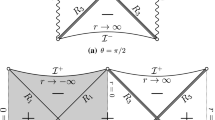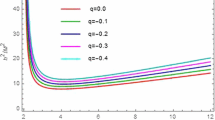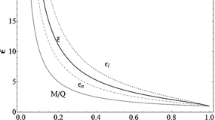Abstract
We investigate the motion of electrically charged test particles in spacetimes with closed timelike curves, a subset of the black hole or wormhole Reissner–Nordström-NUT spacetimes without periodic identification of time. We show that, while in the wormhole case there are closed worldlines inside a potential well, the wordlines of initially distant charged observers moving under the action of the Lorentz force can never close or self-intersect. This means that for these observers causality is preserved, which is an instance of our weak chronology protection criterion.
Similar content being viewed by others
Notes
The positivity condition (4.9), derived under the assumption \(\Psi (r)+4E>0\), is sufficient because \(\Psi (r)+4E\le 0\) is possible only if \(E<0\), so that \(4(\overline{l}^2-E\Psi (r)) > 0 \ge \Psi (r)(\Psi (r)+4E)\).
Note that (4.13) means \(\mathcal{E}(\infty ) = \overline{b}\gamma - \beta /2 \le -1\), leading to \(W(\infty )\le 0\), so that the CWLs at \(r=0\) could be accessed by quantum tunnelling from infinity, but only if negative effective energies were allowed, which we have excluded.
References
Hawking, S.W., Ellis, G.F.R.: The Large Scale Structure of Space-Time. Cambridge University Press, Cambridge (1973)
Hawking, S.W.: Phys. Rev. D 46, 603 (1992)
Gödel, K.: Rev. Mod. Phys. 21, 447 (1949)
Taub, A.H.: Ann. Math. 53, 472 (1951)
Newman, E., Tamburino, L., Unti, T.: J. Math. Phys. 4, 915 (1963)
Brill, D.R.: Phys. Rev. 133, B845 (1964)
Misner, C.W.: J. Math. Phys. 4, 924 (1963)
Zimmerman, R.L., Shahir, B.Y.: Gen. Relativ. Gravit. 21, 821 (1989)
Clément, G., Gal’tsov, D., Guenouche, M.: Phys. Lett. B 750, 591 (2015). arXiv:1508.07622 [hep-th]
Clément, G., Gal’tsov, D., Guenouche, M.: Phys. Rev. D 93, 024048 (2016). arXiv:1509.07854 [hep-th]
Novello, M., Svaiter, N.F., Guimarães, M.E.X.: Gen. Relativ. Gravit. 25, 137 (1993)
Cebeci, H., Özdemir, N., Sentorun, S.: Phys. Rev. D 93, 104031 (2016). arXiv:1512.08682 [gr-qc]
Kagramanova, V., Kunz, J., Hackmann, E., Lammerzahl, C.: Phys. Rev. D 81, 124044 (2010). arXiv:1002.4342
Bañados, M., Teitelboim, C., Zanelli, J.: Phys. Rev. Lett. 69, 1849 (1992). arXiv:hep-th/9204099
Bañados, M., Henneaux, M., Teitelboim, C., Zanelli, J.: Phys. Rev. D 48, 1506 (1993). arXiv:gr-qc/9302012
Moussa, K.Ait, Clément, G., Leygnac, C.: Class. Quantum Grav. 20, L277 (2003). arXiv:gr-qc/0303042
Bouchareb, A., Clément, G.: Class. Quantum Grav. 24, 5581 (2007). arXiv:0706.0263
Anninos, D., Li, W., Padi, M., Song, W., Strominger, A.: JHEP 0903, 130 (2009). arXiv:0807.3040
Moussa, K.Ait, Clément, G., Guennoune, H., Leygnac, C.: Phys. Rev. D 78, 064065 (2008). [arXiv:0807.4241]
Acknowledgements
We thank Dmitry Gal’tsov for fruitful discussions and suggestions, and Júlio Fabris for valuable comments. MG acknowledges the support of the Ministry of Higher Education and Scientific Research of Algeria (MESRS) under Grant 0092009009.
Author information
Authors and Affiliations
Corresponding author
Appendix: Circular orbits with \(r\ne 0\)
Appendix: Circular orbits with \(r\ne 0\)
From (3.15) and (3.16), \(\beta \) and \(\delta \) can be expressed in terms of z as
Using this, we obtain from (3.10)
which can be inverted to
We also obtain from (A.1) and (A.2) the value of the effective energy \(\mathcal{E}(r_0)=E_0+(\beta /2)y_0\):
so that the effective energy is positive provided
In the black-hole case or extreme-black-hole case, \(-2\le \alpha \le -1\), (A.3) is positive definite provided
so that the circular orbits must be outside the horizon (\(r_0>r_h\)). The allowed range of z is then from (A.2)
leading from (A.1) to the condition for the existence of these circular orbits:
In the wormhole case, \(\alpha >-1\), \(y_0\) can vary in the full range \(0<y_0<1\), leading to the allowed range of z
[where \(\overline{b}\) and \(\gamma \) are related to \(\alpha \) and \(\overline{l}^2\) by (3.8)]. Both cases lead to the same bounds for the existence of an unstable circular orbit of radius \(r=\pm r_0\),
For \(\alpha >0\), the lower bound ensures that the first existence condition (3.13) is satisfied, due to the identity
Note that in the parameter range (A.10) there is also from (3.9) a stable circular orbit at \(r=0\).
Rights and permissions
About this article
Cite this article
Clément, G., Guenouche, M. Motion of charged particles in a NUTty Einstein–Maxwell spacetime and causality violation. Gen Relativ Gravit 50, 60 (2018). https://doi.org/10.1007/s10714-018-2388-y
Received:
Accepted:
Published:
DOI: https://doi.org/10.1007/s10714-018-2388-y




